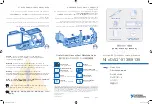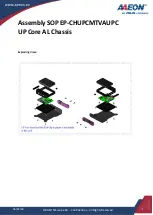
Circuit Descriptions, Abbreviation List, and IC Data Sheets
9.
9.7.4
Sync Flow 3fH input sync signals
3fH Sync Signals
•
The input signals do not come via the HIP and PICNIC but
via the AD9883A. This AD converter delivers H and V sync
signals to the EBILD (H-2FH-AD-OUT and V-2FH-AD-
OUT).
•
The sync signals are the same as with 2fH inputs.
3fH Clock Signals
•
The master clock is delivered by the AD9883, same as 2fH
inputs; The EBILD uses this clock as sample clock for
video control.
9.8
Control
Figure 9-15 OTC interfacing
9.8.1
"Switch On" Behavior
See paragraph "Power States" in this chapter.
9.8.2
OTC Flash
See paragraph "Software Upgrading" in this chapter.
9.8.3
Keyboard
The local keyboard is connected to P2-4 (pin 107) of the OTC,
which is an A/D pin. Each key matches with a range of voltage
values within the A/D converter.
9.8.4
LED Control
In USA the same LED configuration is used as in Europe, the
2-color LED.
Table 9-7 LED control
9.9
Protections
9.9.1
General
Under certain fault conditions, as described below, the set must
go into the "protection state". This means that the set is
switched into standby and displays a blinking LED. These
protections are introduced in order to avoid unacceptable
temperature rises and burning hazards. The failure cause will
be identified and placed into the NVM error buffer. For the
customer, it is made impossible to switch "on" the set with his
remote control.
On the other hand, it must be possible to read out the error
codes from NVM while using a Dealer Service Tool or a
ComPair tool, or to de-activate the protection states in Service
Default Mode. It is possible to enter ComPair from protection
but not from standby.
The protection algorithms are activated/de-activated at a
certain stage in the "start-up/switch-off" sequence of the set
(see also figure "Step wise start-up diagram" in chapter
"Service Modes, Error Codes, and Fault Finding").
9.9.2
Hardware protections
Short-circuiting the 3V3 supply from the DC/DC converter will
shut down the DC/DC converter. There are no hardware
protections foreseen that switch "off" the supply.
There are several types of software related protections, solving
a variety of fault conditions:
•
Protections related to supply: check if the +8V coming from
the main supply and the +5V coming from the standby
supply are present.
•
Protections related to temperature problems in the DC/DC
converter, which supplies the FBX, EBILD, 3D Comb, and
tuner.
These protections use various mechanisms of detection:
•
Via polling on I/O pins going to/coming from the OTC: +5V
and +8V.
•
Via a "not acknowledge" state of the I2C bus: for FBX,
EBILD, 3D Comb, and tuner.
Protections with detection via I/O lines of the OTC
8V protection
The +8V information is an ADC input of the microprocessor.
This input can sense the absence of the +8V. The failure is
filtered by software and put in the error buffer for serviceability.
The set must go into protection.
CL 36532064_060.eps
201003
ON-OFF LED L = Red LED ON
STANDBY H= ST-BY
Degaussing = Active Low
Sound Enable active Low (H= Mute)
PWM backlights
SEL-IN2
HD@HOME to HOP (active H)
Reset -Audio to MSP
Protection s8V (err 5)
Protection s5V (err 4)
Light sensor
SAM Service Mode (active Low)
RGB Blending
Frame
SEL-IN-1
Front Detect (Headphone Detection)
Program-FPGA
OTC
SAA
5801
103
104
113
93
115
117
94
95
81
77,78,79,80
116
118
100
96
119
110
107
105
106
5
83,8
74
99
98
114
Audio I/O Selector LSB
Audio I/O Selector MSB
SDM Service Default (active Low)
CVBS TXT
H / V
RESET
Audio protect
RC5/RC6 IR receiver
POR Flash
Keyboard
Condition
Two colour LED
On
Green
Off
No indication
Low power standby
No indication
Standby
Red
Semi-standby
Orange (red and green)
Reaction on RC in On-state Orange (green and (red
blinking))
Reaction on RC in Standby Red
Reaction on RC in Semi-
standby
Orange (green and (red
blinking))
Protection
Red blinking
FTL13U_AA_AB_312278513481.book Page 150 Thursday, December 30, 2004 1:50 PM




































